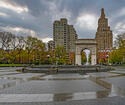Late in the last decade, domestic migrants began moving to smaller metropolitan areas and micropolitan areas (CBSA’s) as domestic migration to the larger metropolitan areas fell. The trend was covered in “Domestic Migration to Dispersion Accelerates (Even Before Covid).” The trend has continued, especially in the year ended July 1, 2021, according to Census Bureau estimates. read more »
Suburbs
Net Domestic Migration: Shift to From Larger Metros to Smaller Areas Accelerates
- Login to post comments
Huge Spike in Domestic Migration from Urban Cores
Net domestic migration losses spiked perhaps as never before in the pandemic year of 2021 among urban core counties --- the counties that contain the urban cores read more »
The Biggest Cities Are Past Their Prime
As the centers of media and political discourse, large cities, notably New York, have a unique ability to promote themselves, asserting that dense, core urban areas own the future. Yet in reality, even during good times, and well before the pandemic, Americans have been headed, in increasing numbers, to suburbs, exurbs and to smaller cities. read more »
- Login to post comments
Census 2021 Estimates: Increased Dispersion
According to the US Census Bureau, the year ended July 1, 2021, grew the slowest of any year on record. The driving factor was the Covid-19 pandemic, which increased morbidity and substantially reduced the natural increase of population (births minus deaths). read more »
Flyover Country Needs to Keep Our Biggest Edge: Housing Affordability
If there’s one location advantage for the heartland that’s become clear during the last several years, it’s the edge we enjoy over the coasts in housing affordability. read more »
- Login to post comments
Canada: Suburbs Dominate Growth - 2021 Census
Canada has released early results of the 2021 Census, with a detailed analysis of growth in Census Metropolitan Areas (CMAs). Among the 41 metropolitan areas, 77% of the population growth between the 2016 and 2021 censuses was in the suburbs, with 23% in the urban core (Figure 1). The suburbs have 78.5% of the total CMA population, with 21.5% in the urban core (Figure 2) read more »
- Login to post comments
Is Suburbia’s Global Benchmark Share of Urban Jobs 87%?
“The great enemy of truth is very often not the lie--deliberate, contrived and dishonest--but the myth--persistent, persuasive, and unrealistic. Too often we hold fast to the cliches of our forebears. We subject all facts to a prefabricated set of interpretations. We enjoy the comfort of opinion without the discomfort of thought.” read more »
Nashville: The Evolving Urban Form
Nashville’s has long been known as “Music City,” a title that dates nearly a century to 1925 when the first “Grand Ole Opry” performance was held in the Ryman Auditorium (above). For even longer, Nashville has been the capital of Tennessee, with the 10th oldest state capitol building in the nation (below). But the big story increasingly has been the area’s rapid growth read more »
The Next American Cities, a New Report from Urban Reform Insitute
The urban form has shifted throughout history. This has been critical to its success. Today we are on the cusp of another transition, ushered in by new technologies and changing demographics, and accelerated by a devastating pandemic. Although these forces affect all geographies, the best chance of success and growth lies in what we define as The Next American City. read more »
- Login to post comments
New U.S. Census Bureau Population Estimates: A New World?
The United States Census Bureau released its July 1, 2021 population and annual net domestic migration estimates for states and the District of Columbia on Tuesday, December 21. This article highlights trends from that release. read more »






















